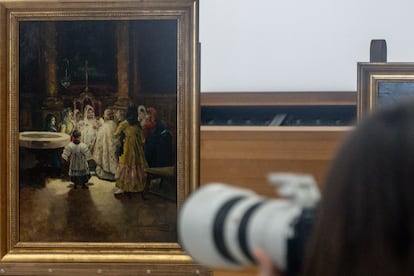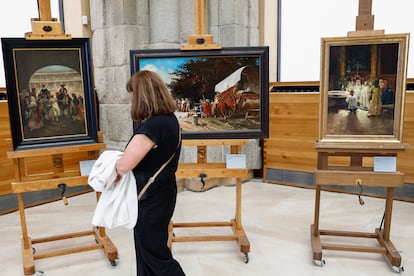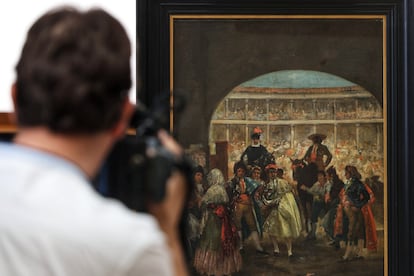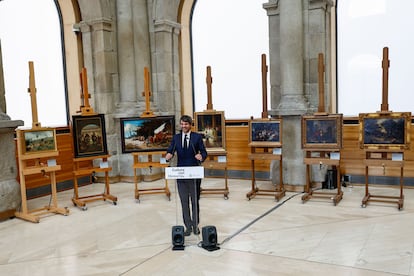The Ministry of Culture has returned seven works seized during the Civil War, almost 87 years ago, to the family of its owner, the first Republican Mayor of Madrid, Pedro Rico. Two of them –Majos and Celestina scene y Assault on diligence— They had so far been shelter at the Prado Museum, which has first returned paintings seized during the contest to their legitimate owners. Those two have joined another five, from different state museums in charge of the Ministry: The pilgrimagewhich was in the National Museum of Romanticism; The per diem and The baptism, in the suit museum; Pilgrimage, in the Museum of Fine Arts of Valencia; and Bullfighters output, in the Museum of Malaga. They were all in a temporary deposit situation.
The works – not well known or of great economic value – have been exhibited this afternoon in a Prado room on seven easels, for the first time twinned by a fact that reads in the chips that accompany them: Pedro Rico collection. To receive them, the grandchildren of the legitimate owner, Francisca and Pedro Rico Gómez have been presented in the National Pinacoteca. “Recovering the works is a relief to the memory of our grandfather,” she said, in front of the seven canvases and before the looks of the Minister of Culture, Ernest Urtasun; the general director of Cultural Heritage and Fine Arts, Ángeles Albert; The president of the Royal Board of Trustees of the National Museum of the Prado, Javier Solana, and the directors of the museums who collaborated in the return.
Rico’s works, “a mayor who subscribes one by one the great social transformations promoted by the Second Republic,” Urtasun said, were seized on June 9, 1938, at his home in Madrid, by the Madrid Socialist Group. An seizure, like so many others, made with the aim of protecting them during the war. But the subsequent situation with Francoism became – new, like so many others – in an indefinite deposit, and the works were distributed by the different museums that return them today.
“It is today admirable and moving that this period of death and repression, of indoctrination and lack of freedom did not achieve, however, to erase the trail of what we are celebrating here today in this act: culture as an emblem and wise essential of democracy,” the minister in the appearance continued, where questions from the press were not accepted.
His ministry took the first big step in the long road to the return of artistic works seized, in the middle of last year. Urtasun presented an inventory, which now exceeds 6,000 works – cheers, jewelry, ceramics, sculpture, fans or vessels – that, according to an internal investigation, come mainly from seizures made by the Republic during the Civil War. From that investigation – which at the moment only includes the 16 state museums – six works have been returned today. Five are those in this afternoon – existing those of the Prado – and one more that was delivered to the Francisco Giner de los Ríos Foundation in December.



The two works of the Prado are, in fact, the result of an investigation commissioned by the museum almost two years before, in September 2022, of the Ministry’s catalog. The rich family lawyers were the first to formally request the return that three years later have achieved.
“It is a late repair story, without a doubt,” Urtasun confirmed. But he justified, with the approval of the two heirs, the delay: “We deliver these pieces, after a thorough and reasoned audit, to its legitimate owners with all the guarantees and legal guarantees that it has demanded such a prolonged process: bureaucratic reports and tangle.” And he added that it is “the fulfillment of a duty with memory, with justice and culture; also with the truth of the facts and their legal demonstration.”
Francisca and Pedro Rico Gómez, who listened to the minister’s words in the front row, have been protagonists for years of this complex journey. The Octogenarian brothers themselves appeared in the Canary Islands, in November last year, to receive another five paintings from their grandfather, then stored at the Museum of the Cabildo de Gran Canaria. That was the first return of works of art seized to victims of the dictatorship carried out within the framework of the Democratic Memory Law, one of the initiatives most defended by the Government of Spain.
In addition to today’s returns, the octogenarian brothers prepare their bags for Asturias, where the Minister of Culture of the Principality already organizes their own act to restore the family with a couple of works in the care of the Museum of Fine Arts of Asturias. “This is the end point of a story, but it is the beginning of another,” Albert also said at the event. Perhaps the media path of the Rico brothers serves to look for protagonists of new stories. There are some more requests, although sources from the Ministry claim not to know the exact number, of return of works. The process is complex, long and tedious, but there are still, in the hands of the Ministry, another 6,000 stories to tell.


